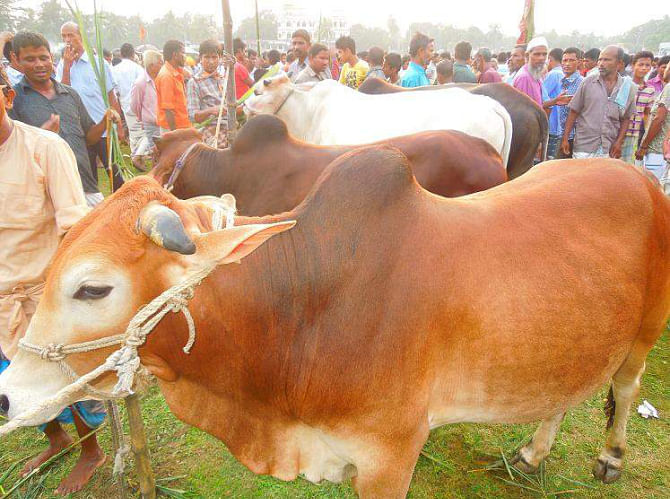Cattle wrongly fattened for Eid pose health risk
Cattle wrongly fattened for Eid pose health risk

A large portion of the cattle meant for sale as sacrificial animals ahead of the Eid ul Azha are unscientifically fattened and disease affected.
Meat of such cattle often poses serious health hazard, doctors said.
In northern districts, including Rangpur, Dinajpur, Nilphamari, Gaibandha, Kurigram, Lalmonirhat, Thakurgaon and Panchagarh, farmers fatten varieties of oxen and bulls like cross breed, Pabna breed, Indian Haryana breed, Australian Friesian breed, and Pakistani Shahiwal breed, sources said.
For fattening cattle, livestock officials suggest de-worming the animals and then feed them, along with other usual food, proportionate mixture of urea, molasses and straw (UMS) 2-2.5 kg daily.
If the cattle are too weak, they might be given limited dose of vitamin B-12 injections.
For preparing UMS mixture, farmers should keep one kg of straw cut into 2-3 inch pieces, 700 ml water, 225 gram molasses and 30 gram urea in a closed container for eight days and then dry it in the sun to use as fodder, goes the suggestion of the livestock officials.
If this process is followed, the cattle gain up to one and a half times weight within six months and consumption of their meat is safe for human health, they said.
But a section of dishonest cattle traders and farmers ignore the suggestion and push steroid and hormone injections to the cattle's body indiscriminately and feed them much urea to make them weigh double or triple.
“We never suggest using steroid, hormone, high dose vitamin injections or excess urea to fatten cattle,” said Shahjahan Khondokar, district livestock officer in Nilphamari.
"Steroids cause accumulation of fluid in cattle and make them look fatter. But this fluid attacks their immune system, making them vulnerable to deadly diseases. Excessive use of vitamins makes cattle feel uneasy while much urea has toxic effect," he said.
Artificially fattened cattle look bulky but they lose liveliness, vigour and energy and their life span shortens, said livestock officials and cattle traders.
"If anybody consumes meat of diseased cattle for long, he may get kidney problem, liver failure, gastric ulcer, diabetes, pancreas diseases, uncontrolled high pressure, skin diseases and others that may eventually lead to the person's death," said Dr Sneha Kumar Chakma, civil surgeon of Nilphamari.